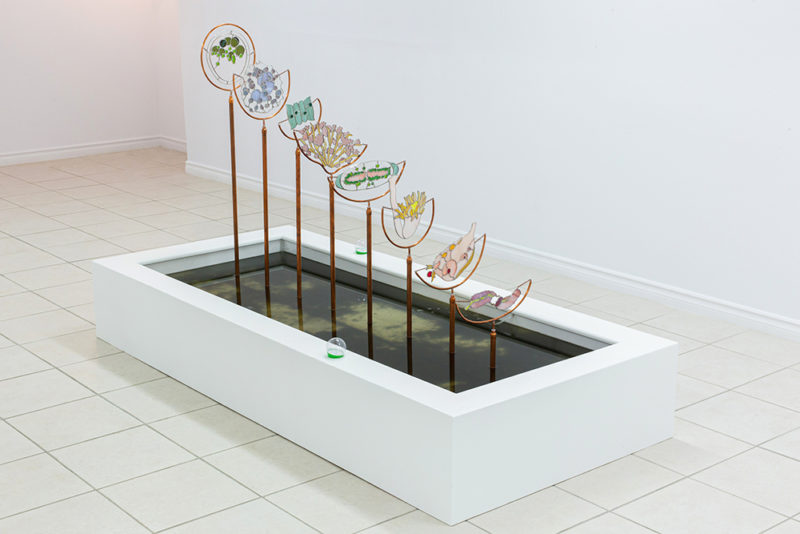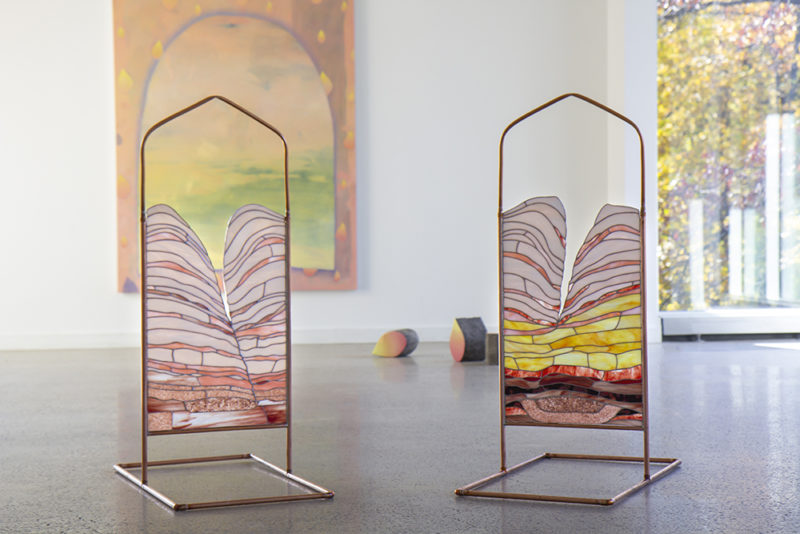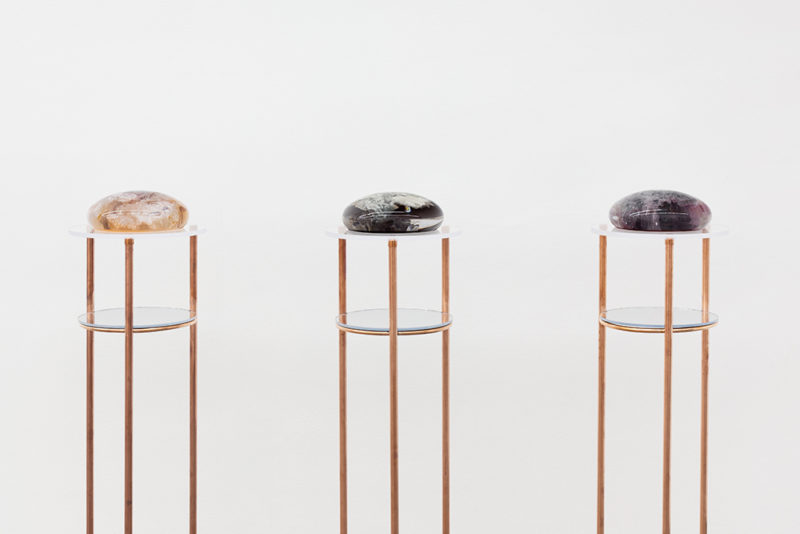Mutable Matters: A Conversation with Laura Hudspith
15 March 2023By Katie Lawson

I first came across Laura Hudspith’s work in 2019, which coincided with a shift in the artist’s practice to a more autotheoretical approach that draws on her lived experience with chronic illness. At that time, I was months deep into my own isolating and confusing journey that would eventually lead to the diagnosis of fibromyalgia, the latest in a growing list of medical conditions that have shaped my life to date. I was immediately drawn to Laura’s compelling use of object, image, and text in relation to both the individual and the collective body. I felt a wave of relief; I felt seen. Despite the fact that I initially encountered Laura’s work virtually, the impact of her practice is evident in the sense of connection and comfort it offered me in a time marked by unknowing.
Splitting her time between Pittsburgh and Toronto, Laura has since continued to deepen her engagement with the intersections of art, critical theory, politics, and medicine, resulting in a wide range of material experimentation as she works towards the completion of her graduate degree. This winter, I had the privilege of sitting down with Laura for an in-depth conversation about her practice, traversing multiple bodies of work from 2020 to the present day.
Katie Lawson: Thank you for taking the time to share your practice with me, Laura. As you know, I’ve followed your work for a number of years, and I feel especially grateful that you have made time to connect as you enter the final stages of production for your MFA thesis exhibition at Carnegie Mellon. This feels like a meaningful moment to share insights into your recent work, and what is still to come.
I want to start by discussing your use of both commonplace and unusual materials. This is what first drew me to your work, and it seems that you have developed a strong aesthetic sensibility to evoke the individual and collective body in relation to health and sexuality, chronic illness, and healing. Could you speak to an instance of experimentation in the studio where material transformation has had strong resonances with your conceptual concerns, or perhaps produced unexpected results that have shifted your thinking?
Laura Hudspith: Thank you, Katie. It’s wonderful to be able to connect with you in this way. And thanks for this question; it feels like a great place to start. Encountering the unexpected is what most excites me—whether through an intent to experiment, by mistake or through experimental ‘collaborations,’ as I like to think of them, with the matter/bodies of and within my work. Not surprisingly, I began making work related to illness and healing following my first major experience of an autoimmune flare. My earliest explorations in this sphere relied on object and material signifiers that could stand in for ‘bodiliness’ in some way, or for some facet of the complex space between illness and medicine/s, health and ‘wellness.’
Soon after, I became more interested in materials that could tell me something about their bodies and being, deepening or challenging my own knowings. I started to work with copper—an elemental metal used for a variety of medicinal purposes from hospital infrastructure to birth control—building out body-like schema in works like en- / un- / -en (2020). Copper is in a constant state of becoming. Each atom in motion has a free electron that is, in a way, searching for a space to be, and being in copper’s presence helps reorient my thinking on bodies and illness by embracing that changefulness. Copper and I collaborate. Surfaces are seeded by my touch, a residue of care and our collaboration that initiates a process of transformation whereby an oxidized skin forms across its body.
KL: Copper feels like a particularly strong instance in which the way that you work with it, or that it collaborates with you, draws attention to the agency and transformative potential of a material that some perceive as inert. It strikes me that there is this element of chance or a relinquishing of control in the process of making some of your more site-responsive work, like Bloom (2021).

LH: Working on Bloom—a pond installation that explores the erotic potential of becoming molecular—presented another opportunity for peculiar collaboration, this time with ‘live’ matter. Stained glass lenses depicting algal and human cellular structures emerge from within a liquid culture of filamentous algae. The work pairs those cellular structures, which in my experience are the first to register autoimmune symptoms, with various agal bodies local to our environment. Each carries a name, a knowledge, that seemed to me to emerge on its own from within that cellular body’s innate characteristics, “the rhizomorph (breast tissue)” and “the traveller (volvox ferrisii),” for example. Together, the eight glassworks imply a human-algal hybrid with a unique set of erotic wisdom.
KL: Wisdom feels like a very generative word to bring into our discussion, particularly in relation to these elements of chance and control. If we understand wisdom as the body of knowledge acquired through experiences, I’m thinking of the particular wisdom that accumulates in navigating autoimmune flares—I know that in my experience with chronic illness I came to know myself and my body in a completely new and different way in the process of trying to care for myself, or manage the daily ebbs and flows of ability. In our correspondence, you have also referenced wonder as a form of molecular healing, and I was hoping that you could expand on this. It feels akin to a kind of introspective curiosity, a more gentle and less pathological relationship to one’s own bodily state.
LH: It means a lot to talk about the intimacies of illness with you in this way, so thank you for sharing your lived experience with me. Yours resonates with my own in many ways, shifting how I feel that I know what I know of myself and the matters that comprise me, as in a new mode of encounter.
This question of wonder is really at the core of my work and thinking. Self-blame is built into the language of autoimmunity, which is unproductive in the experience of illness, even symptomatically triggering. Allowing, instead, my body and illness to act as guides—for theoretical or ruminative pursuits, and also in a practical or daily sense—has led me to develop a biophilosophy for relearning the world and the body within it as ontologically flexible, and matter as containing a unique sort of agency or animus, and indeed wisdom, without hierarchy, which may or may not become legible. Recognitions along these lines have brought wonder, or the sensation of coming to know something profound, into the experience of illness while unravelling the linguistic knot of auto/immunity. This biophilosophy, which I call feeling with–, doubles as a meditation practice for envisioning the molecular body. It echoes an Audre Lorde erotic ethic by centering looking inwards through deep feeling.1 I’ve found that this experience of wonder begins to matter me to its shape, soothing my body, even avoiding a flare-up altogether.
KL: I definitely want to return to this Audre Lorde reference, but I’d like to linger with wonder for a moment longer now that you’ve shared how expansive it is for you as both a conceptual framework and a personal practice of relating to and caring for yourself. How does this translate into the studio?

LH: In the studio, I play with placing seemingly disparate matter formations in relation to one another, such as the bodily together with the geological in Wounds are to fissures, an invitation for a joining (2021). The stained glass diptych reimagines illness and health as a coetaneous collapsing and telescoping of time/scales. I often find that wonder emerges when we are met with something that is both perplexing to us in some way and all its own. I’m currently building out my thesis exhibition, whose structures will choreograph a slow, meandering and meditative movement between the peculiar objects they uphold, objects which oscillate between containing glimpses of self-image legibility and keeping us wholly outside of them.
KL: I had the pleasure of reading your beautifully written thesis, an autotheoretical accompaniment to your work. In connection with your material practice, I wonder if you might speak to the practice of writing. But perhaps first we circle back to Lorde—I get the sense that there are a number of authors who have informed your practice. Illness can be incredibly isolating, and I know I have found solace in the company that can be found in non-fiction or memoir centring very personal experiences with sickness or disability—particularly from femme-presenting folks, as gender plays a significant role in the social construction of health and access to care. Are there certain texts that have been guiding forces for you?
LH: Oh gosh, yes, lots! I do find that there is soothing kinship to be found in the writings of authors who centre their somatic and psychological experiences around illness and disability. I think of Sarah Manguso’s memoir The Two Kinds of Decay, as well as theory-makers like Audre Lorde and Carolyn Lazard whose nuanced, autotheoretical approaches interweave lived experience with political analysis and advocacy work. Lauren Fournier’s many texts on autotheory have been hugely influential on my work and thinking, both in the studio and on the page. I look to theorists such as Jane Bennett and Deboleena Roy, whose texts offer ethical considerations on the various matters that make up our world, our beings, and how we might reorient our thinking for encountering them, each other.
Roy’s Molecular Feminisms: Biology, Becomings, and Life in the Lab is a text that I return to often. I came to Roy’s work rather unexpectedly while researching Jes Fan, an artist I greatly admire—Roy had interviewed Fan for Art in America. I was struck by the flow of their discourse, which seamlessly straddled artistic concerns, biochemistry and endocrinology. As a neuroscientist, behavioural biologist, and gender studies researcher, Roy’s approach to theory-making is interdisciplinary, pulling from experience across these varied disciplines, each with its own unique methods of knowledge production. Being both rigorously researched and beautifully written, Molecular Feminisms has helped me create language around some of the more elusive knowledge that all matter, and indeed a body, holds.
Finally, I’ll share one of my favourite texts: Água Viva by Clarice Lispector. She writes her moment-to-moment experience as she ruminates on the nature of being, her thoughts enriched and complicated by her own deep feeling and reformed within an instant into an inexplicable sort of knowing. Through this process, she arrives at her own version of experiencing the healing potential of what I call wonder—though she calls it “grace,” I believe—when thoughts of this nature seem at once to obliterate and to rebuild her anew, more aware and less fearful.2
KL: [laughing] This is amazing, I had a feeling you would have a wealth of references to share—readers of this interview get a bonus curriculum! I’ll be adding some of these to my own lists. Returning to your own writing: in your thesis, you point to the limitations of language in relation to experiences of chronic illness. I’m thinking in particular of the absurdity of pain scales, and quantifying bodily experiences in the hopes of grasping shared comprehension with medical professionals. At the same time, there does seem to be something very productive for you in the realm of language.
LH: [laughing] Well, it won’t shock anyone to say that communicating effectively can be challenging on a regular day. Medical settings further complicate the task in many ways—some by design, as in reductive triage questionnaires, others for the maintenance of critical distance between doctor and patient. Communicating a pain that leaves no visible or otherwise easily measurable trace, as in fibromyalgia, is another challenge altogether.
Before getting sick, I never thought of myself as a writer. During those first few months of illness, at home and largely bed-bound, my perception of time grew strangely elongated, but also not—a feeling that I think has resonance for most following the upheavals of COVID. Hospital visits were really the only events that punctuated my experience of time. I needed a way to mark its passage and to record—in hopes of understanding—the wild musings and absurd diagnoses I received, which ranged from dismissal to tropical fish poisoning. Words can stick to us, permeate our pores, permutate our bodies and beings as they interact with our tissues. I began writing: notations at first, then my thoughts. Before long, this grew into essay and poetry writing. Unlike copper, words do not carry an inherently positive or negative ionic charge, but I’ve come to know language as a form matter, or an ‘immateriality’ capable of mattering us. This ontological reorientation allows me to approach language as material for playful experimentation in-text, as each word is troubled by its own multiplicity and mutability. All that is to say that over the years, writing has become a vital part of my practice that informs my visual work and vice versa.
KL: Language, materials, bodies—they are all mutable! There’s something about writing (and reading) that occupies a different temporality. I think it’s important that you’ve referenced the change in your perception of time, how it becomes elongated or punctuated by the conditions of illness and treatment respectively. I have found the idea of crip/sick time coming out of disability studies to be helpful in making sense of these shifts. Fibromyalgia disrupts linear, progressive time with its uneven pacing, its backward and forward acceleration, stops and starts, relapses and flares. In returning to your physical work, I’m curious if there is also an interest in reclaiming temporal flows, as the more cyclical processes of decay and renewal are often at play.

LH: The flow of time, whether it falls within or without our ability to perceive its passage, is a thread that connects much of my work. Drawing upon my relationship with saline drips, salts—medicinal or otherwise—have become an important material collaborator of late. Together, we’ve been creating a series of Orb sculptures that will be featured in my thesis exhibition. The orbs are small, molecular or cell-like objects that contain within them, for a time, silk photographs of my body taken during moments of illness. Much like water, dissolved salts need a reminder of their bodies’ ability to form crystals. Having been submerged in various brines, the silken fibres of my self-images are points for crystal nucleation, and an invitation for this enduring matter to envelop a document of my being. As the salts slowly form their crystalline structures, they warp and curl the material, eventually forming a small, rigid object that I cast into a type of resin that degrades under ultraviolet light.
Salt has a relatively stable molecular structure, which has no doubt contributed to its cultural association with longevity. Clearly, however, this does not preclude its innate changefulness; salts in the orbs are on the move, slowly shifting, corroding and cracking their resin encasement. With the addition of sunlight to denature the resin, I am no longer the sculptures’ author. Part of the ethos of the work, as I see it, is respecting this process of decay. Eventually, though not within the span of our lives, the salt will be all that remains. Rather than reclaiming temporal flows, the work points to the existence of other-than-human timescales, which I believe can deepen and complicate our worldview in productive ways.
KL: It’s so interesting that in working with both salt and ultraviolet light, the work then embodies aspects of preservation and decay simultaneously. In terms of your work with images, there’s also this play between transparency and opacity, legible representation and abstraction.
You mentioned that these Orbs will be part of the presentation of your thesis work. I know you are still producing this body of work, but I would be curious to hear how we might expect it to be realized in the form of an installation.
LH: Using only minimal overhead lighting, I have designed the installation space to be dark enough to simultaneously evoke the incomprehensible spaciousness of the cosmos and the slightness of the molecular body. The Orbs are translucent. Perched atop a series of thin, steel structures, each Orb sculpture will be illuminated from below, their lens-like forms refracting light within and leading viewing bodies through the space. In this darkened setting, the structures will feel spare and cold, while their plasma-cut edges will lick up at the geometrically ‘pristine’ orbs with a charred, toothy gnarl. The installation may be read as either emanating from or having been caught in the midst of being poured into a large glass sculpture at the installation’s core. Revealing itself slowly via the wandering of its viewing bodies, the varied structures will slightly obfuscate each other as those that are closer to the central work will be nearer to its shorter stature, creating a subtle funnelling effect.
KL: This sounds beautiful, and certainly like the kind of work that really deserves to be seen in person, given that these considerations of the embodied experience of the installation extend into the environment of its presentation. I for one cannot wait to come down to Pittsburgh to see it realized! Thank you so much once more for this conversation and your work.
- Audre Lorde, Uses of the Erotic: The Erotic as Power (Brooklyn, NY: Out & Out Books, 1978), 2.
- Clarice Lispector, Água Viva, ed. Stefan Tobler, and Benjamin Moser (London: Penguin Classics, 2014), 79.
The infinitesimal stirs me as the cosmological by Laura Hudspith is a part of the MFA thesis exhibition thump, whoosh, rumble running from March 24 – April 16, 2023 at Miller ICA, Carnegie Mellon University in Pittsburgh, USA.
Feature Image: Installation view of en- / un- / -en, 2020 by Laura Hudspith. Photo by Laura Findlay, courtesy of the artist and Zalucky Contemporary.



